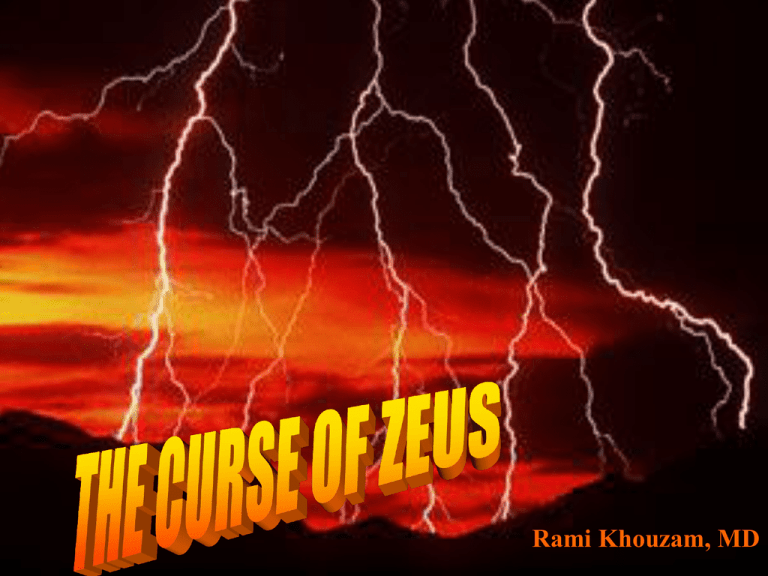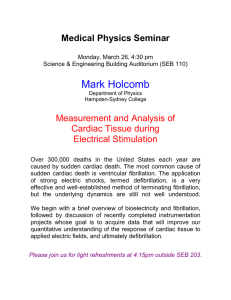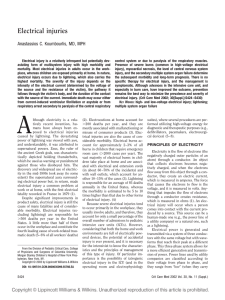Rami Khouzam, MD
advertisement

Rami Khouzam, MD The Statue of Zeus at Olympia • An enormous statue of the Greek father of gods, carved by the great sculptor Pheidias • In his right hand a figure of Victory made from ivory and gold. In his left hand, his scepter inlaid with all metals, and an eagle perched on the sceptre • The sandals of the god are made of gold, as is his robe Pausanias the Greek (2nd century AD) 7 Wonders of the Ancient World • Today, archaeological evidence reveals some of the mysteries that surrounded the history of the Wonders for centuries • For their builders, the Seven Wonders were a celebration of religion, mythology, art, power, and science • For us, they reflect the ability of humans to change the surrounding landscape by building massive yet beautiful structures, one of which ( the Pyramid) stood the test of time to this very day Index Case • 42-year-old white male • No significant past medical hx. except x possible marijuana • Was working on a ladder 12 feet high • Electrocuted with 440 volts • Contact burns to bilateral hands • Prior to arrival to the hospital: • SVT --> Cardioversion x 5 • Hypotension --> Dopamine and Epinephrine drips • Intubated • Vitals on arrival: – Pulse: 101 – BP: 71/46 – RR: 24 PE (pertinent findings): • Neck in C-collar • Ears: some blood behind Lt. tympanic membrane • Chest: Bilateral crackles • Heart: S1S2 RRR Few extra-beats, No m,g,r • Upper extremities: 2nd & 3rd degree burns on the palmar aspects of both hands • Labs: • • • • • • K: 3.1, Cr: 1.1 WBCs: 27.8 10.5 AST/ALT: 63/54 ABGs: 7.25/43.8/213.7/18.6/99.1% Lactic a: 4.2 UDS: + methamphetamine Trop CK CKMB CKMB index Myoglobin 1.38 989 19.4 2.0 > 500 2.87 1.81 2190 17.2 0.8 > 500 • • • • • • Swan-Ganz: PCWP: 19 PA: 31/14 CVP: 15 CO: 16 / CI: 11 SVR: 335 MAP: 80 CXR: • Interstitial & alveolar pulmonary opacities centrally with relative sparing peripherally: consistent with pulmonary edema TTE on admission • Mild eccentric LVH • LV systolic function was moderately to severely decreased • EF: 25-30% Day 3: • Levophed discontinued • Weaned off of the vent & extubated • Blood culture: MRSA Day 8: • Discharged home on: pain meds & antibiotics TTE (prior to d/c) • Normal left ventricular systolic function • EF: 65% The Hanging Gardens of Babylon • A palace with legendary gardens built on the banks of the Euphrates river by King Nebuchadnezzar II ELECTRICAL INJURIES Critical Care Medicine Volume 30.Number 11.November 2002 • Adults in workplace, children at home • Severity of injury depends on: – Intensity of electrical current (voltage of source and resistance of victim) – Pathway through victim’s body – Duration of the contact with the source Immediate death may occur from: 1) Current-induced ventricular fibrillation 2) Asystole 3) Respiratory arrest secondary to: – Paralysis of the central respiratory control system – Paralysis of the respiratory muscles History Overview • Lightning was attributed to supernatural powers • Zeus ruler of the ancient Greek gods holding thunderbolts which he used as warning or punishment against who disobeyed him • Zeus, the youngest son of Cronus and Rhea, was the supreme ruler of Mount Olympus and of the Pantheon of gods who resided there • Being the supreme ruler he upheld law, justice and morals, and this made him the spiritual leader of both gods and men • Zeus was a celestial god, and originally worshiped as a weather god by the Greek tribes • He has always been associated as being a weather god, as his main attribute is the thunderbolt, he controlled thunder, lightning and rain • Theocritus wrote circa 265 BCE: "sometimes Zeus is clear, sometimes he rains” • He is also known to have caused thunderstorms • Discovery and widespread use of electricity in the mid1800s took away the supernatural aura • 1st electrical fatality recorded in France in 1879 • Thomas Alva Edison was both a scientist and an inventor • Born in 1847 • When Edison was born, society still thought of electricity as a novelty, a fad. By the time he died, entire cities were lit by electricity • In his lifetime, Edison patented 1,093 inventions • The most famous of his inventions was an incandescent light bulb • He believed in hard work, sometimes working twenty hours a day. Edison was quoted as saying, "Genius is one percent inspiration and 99 percent perspiration" • In tribute to this important American, electric lights in the United States were dimmed for one minute on October 21, 1931, a few days after his death • Electrical injuries (excluding lightning) are responsible for > 500 deaths/year in the US • > 1/2 of them occur in the workplace. • 4th leading cause of work-related traumatic death • Electrocutions at home: > 200 deaths/year • Lightning responsible for 93 deaths/year in US • Morbidity 5-10 times higher than that due to other forms of electrical injury • Iatrogenic electrical injury in the ICU: defibrillators, pacemakers, electrosurgical devices • Story of CPR: how to treat electrocuted electrical linemen who were in VF Principles of Electricity • Electricity: flow of electrons (negatively charged outer particles of an atom) through a conductor • When the electrons flow away from this object through a conductor they create an electric current: amperes • Voltage: force that causes electrons to flow: volts • Anything that impedes the flow of electrons through a conductor creates resistance: ohms • Power lines range from: – Low: < 600 volts – Ultrahigh: > 1 million volts • Utility power lines with high voltages in sparsely populated areas • Through a succession of transformers voltage is gradually reduced • Most homes in US & Canada have a 120/240 V other countries (Europe, Asia..): 220 V The Temple of Artemis at Ephesus • A beautiful temple in Asia Minor erected in honor of the Greek goddess of hunting and wild nature Pathophysiologic effects of Different Intensities of Electrical Current • Electrical current exists in 2 forms: 1) AC: (Alternating Current): when electrons flow back and forth through a conductor in a cyclic fashion • It is used in household and offices and is standardized to a frequency of 60 cycles/sec (60 Hz) 2) DC: (Direct Current): when electrons flow only in one direction • Used in certain medical equipment: defibrillators, pacemakers, electrical scalpels • AC is far more efficient and also more dangerous than DC (~ 3 times): tetanic muscle contractions that prolong the contact of victim with source • Issue of safety over efficiency: early days of electricity when Thomas Edison (who developed and popularized DC was fighting against George Westinghouse (who developed AC) • AC: first death penalty by electrocution • Lightning is a form of DC • Occurs when electrical difference between a thundercloud and the ground overcomes the insulating properties of the surrounding air • Current rises to a peak in about 2 µsec • Lasts for only 1-2 sec • Voltage >1,000,000 V • Currents of >200,000 A • Transformation of the electrical energy to heat generated temperatures as high as 50,000ºF • Extremely short duration prevents from melting The Mausoleum at Halicarnassus • A fascinating tomb constructed for King Maussollos, Persian satrap of Caria Determinants of Electrical Injuries • Ohm’s law: Current = Voltage/Resistance • Exposure of different parts of the body to the same voltage different current different degree of damage because resistance varies • The least resistance is found in nerves, blood, mucous membranes and muscles • The highest resistance is found in bones, fat and tendons • Skin’s resistance ranging between 40,000 and 100,000 Ω depending on thickness • Moisture of the skin; electrocution of a person in a bathtub or swimming pool • Moist mucus membranes: significant orofacial injury to infants and toddlers • Nerves and blood vessels are the best conductors: path of least resistance for current after it enters the body • Duration of the contact: shock caused by AC will produce bigger injury than shock caused by DC of the same amperage Pathway of the current through the body: – Vertical pathway parallel to the axis of the body is the most dangerous. It involves all the vital organs; central nervous system, heart, respiratory muscles, in pregnant women the uterus and fetus – Horizontal pathway from hand to hand: the heart, respiratory muscles and spinal cord – Pathway through the lower part of the body: local damage The Colossus of Rhodes • A colossus of Helios the sungod, erected by the Greeks near the harbor of a Mediterranean Island Electrical Injury to Specific Tissues & Organs Cardiovascular System: Pathophysiology: • Direct necrosis of the myocardium • Cardiac dysrhythmias • Focal or diffuse • Widespread, discrete, patchy contraction band necrosis involving the myocardium, nodal tissue, conduction pathways and coronary arteries • A current > 50-100 mA with hand-tohand or hand-to-foot transmission ventricular fibrillation • High-voltage current (AC or DC) ventricular asystole • Lightning cardiac standstill • Sinus rhythm may spontaneously return • Cardiac dysrhythmias reported in survivors of electrical injuries pathogenesis is rather unclear, multifactorial • Possible mechanisms: 1) Arrythmogenic foci due to myocardial necrosis (esp. SA Node injury) 2) Alterations in the Na+ - K+ adenosine triphosphatase concentration 3) Changes in the permeability of myocyte membranes 4) Anoxic injury (respiratory arrest precedes the injury to the heart) • Large arteries not acutely affected because their rapid flow:dissipate heat. Medial necrosis: aneurysm formation and rupture • Smaller vessels acutely affected d.t. coagulation necrosis compartment syndrome Clinical Manifestations • Cardiac standstill, ventricular fibrillation: most serious • Sinus tachycardia, nonspecific ST- and Twave changes: much better prognosis • Conduction defects, various degrees of heart blocks, BBB and QT interval • Supraventricular tachycardias and atrial fibrillation: usually do not cause significant hemodynamic compromise • On echocardiogram: some depression of the right & left ejection fractions Cutaneous Injuries & Burns • Extensive flash and flame burns • Hemodynamic, autonomic, cardiopulmonary, renal, metabolic and neuroendocrine responses Nervous System • Loss of conciousness, confusion & impaired recall • Peripheral motor & sensory nerves motor & sensory deficits • Seizures, visual disturbances & deafness • Hemiplegia, quadriplegia, spinal cord injury • Transient paralysis, autonomic instability hypertension, peripheral vasospasm due to lightning from massive release of catecholamines Respiratory System • Direct injury to the respiratory control center cessation of respiration or suffocation secondary to tetanic contractions of the respiratory muscles • Acute respiratory dysfunction syndrome secondary to ischemia, aggressive fluid resuscitation, ventilator-associated pneumonia Other Systems • Kidneys susceptible to anoxic/ischemic injury • Release of myoglobin & creatinine phosphokinase renal tubular damage renal failure • Fractures • Transient autonomic disturbances fixed pupils may be perceived as severe brain injury or even death • Temporary sensorineural hearing loss The Lighthouse of Alexandria • A lighthouse built by the Ptolemies on the island of Pharos off the coast of their capital city Management of Electrical Injuries Overall fluid management should be judicious unless: SIADH Patient Monitoring • Most severe cardiac complications present acutely • Very unlikely for a patient to develop a serious or life-threatening dysrhythmia hours or days later • Asymptomatic normal ECG do not need cardiac monitoring • Preexisting heart disease: monitor such patients for 24 hrs after the injury • Criteria for cardiac monitoring: – Exposure to high voltage – Loss of consciousness – Abnormal ECG at admission • Type of cardiac monitoring: (controversial) – Continuous telemetry – Serial ECGs – Serial measurement of cardiac enzymes • Prognostic value of CK-MB, noninvasive and invasive imaging studies (echocardiography, thallium studies & angiography): rather poor and inconsistent • Muscles injured by an electrical current can contain up to 25% CK-MB fraction (as opposed to the normal 23%) • No information regarding changes in troponin Prophylaxis... “One ounce of prevention is worth a pound of treatment” The Great Pyramid of Giza • A gigantic stone structure near the ancient city of Memphis, serving as a tomb for the Egyptian Pharaoh Khufu “Man fears Time, yet Time fears the Pyramids” Arab proverb "Genius is one percent inspiration and 99 percent perspiration."


